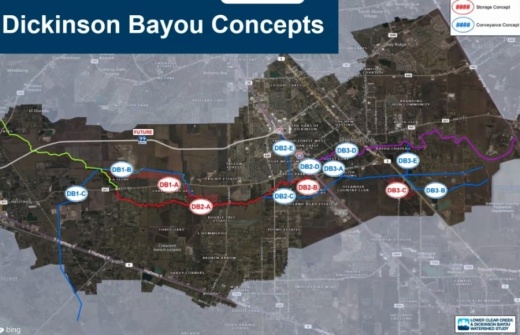On Oct. 28, officials shared the first potential conceptual projects that could mitigate drainage in the region.
Freese and Nichols representatives spoke mainly about Dickinson Bayou projects. They will discuss potential lower Clear Creek Watershed projects at a virtual meeting Nov. 4 at 6:30 p.m.
In the study so far, officials have identified nine conveyance-related projects and four potential storage projects in Dickinson Bayou. The projects were identified by creating accurate models of how the regional floods and how rainwater flows during heavy storms, officials said.
Conveyance projects are those that help move water through an area, such as a bypass channel along a creek to help move more water. Storage projects are those that hold water in a place for a time until it slowly drains out, such as a detention pond.
One proposed conveyance project would be a 27,000-foot bypass that would divert river water from where Dickinson and Magnolia bayous converge just east of I-45. This is a highly hazardous area for flooding, and the bypass channel could run through nearby rural areas to minimize the effect on neighbors of creating the channel, Freese and Nichols Project Manager Brian Gettinger said.
Gettinger said the bypass channel would be similar to canals in the region and would act as a “straw” to take water out of the “bowl” that is the bayou and move it to Galveston Bay. It would only bypass water during heavy storms for the most part, he said.
Another conveyance project includes 7,300 feet of channel widening along Dickinson Bayou and 20,000 feet for a diversion channel across FM 646 and I-45. The widening would improve water capacity along the undeveloped portion of the bayou, and the water would be diverted around the developed area farther downstream, Gettinger said.
“We know we need more conveyance, and the question is: How can we provide it?” he said.
The final potential project the group shared was a detention project. About 14,600 feet of the channel would be improved between McFarland Road and FM 517, Gettinger said.
Significant property would need to be acquired to make the detention area a reality, but it would alleviate flooding downstream and allow for faster drainage in the area, he said.
Gettinger said there are several other projects the group is considering but that these three are a sample of the types of concepts the group has come up with. The next step is to run rain simulations through the model the group has developed to see how effective the projects are at reducing flooding, Gettinger said.
“We’re getting close to the solution sets at this point,” he said.
One thing is for sure: The solutions Freese and Nichols will come up with will not be pumps or gates. The idea is to create “passive” projects that work on their own to minimize the chance of problems during a storm, Gettinger said.





